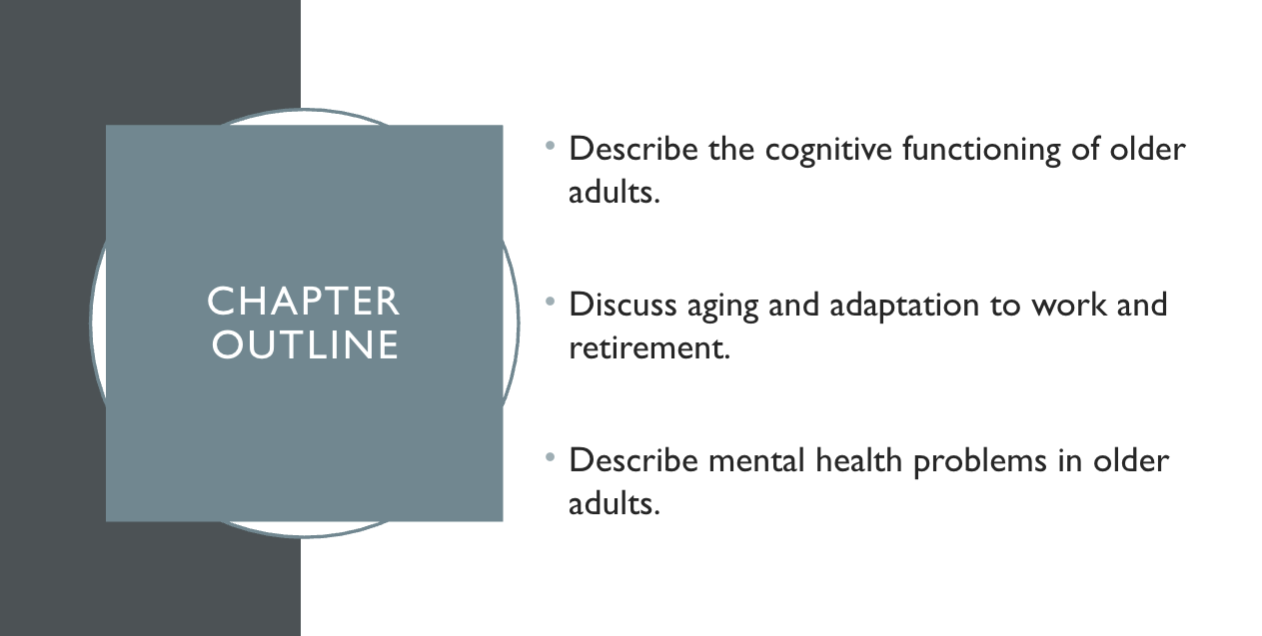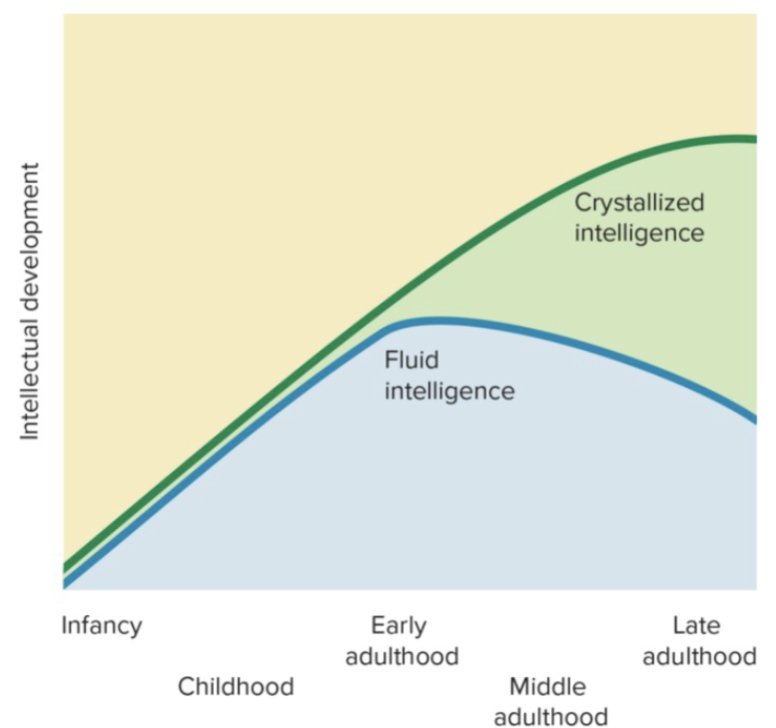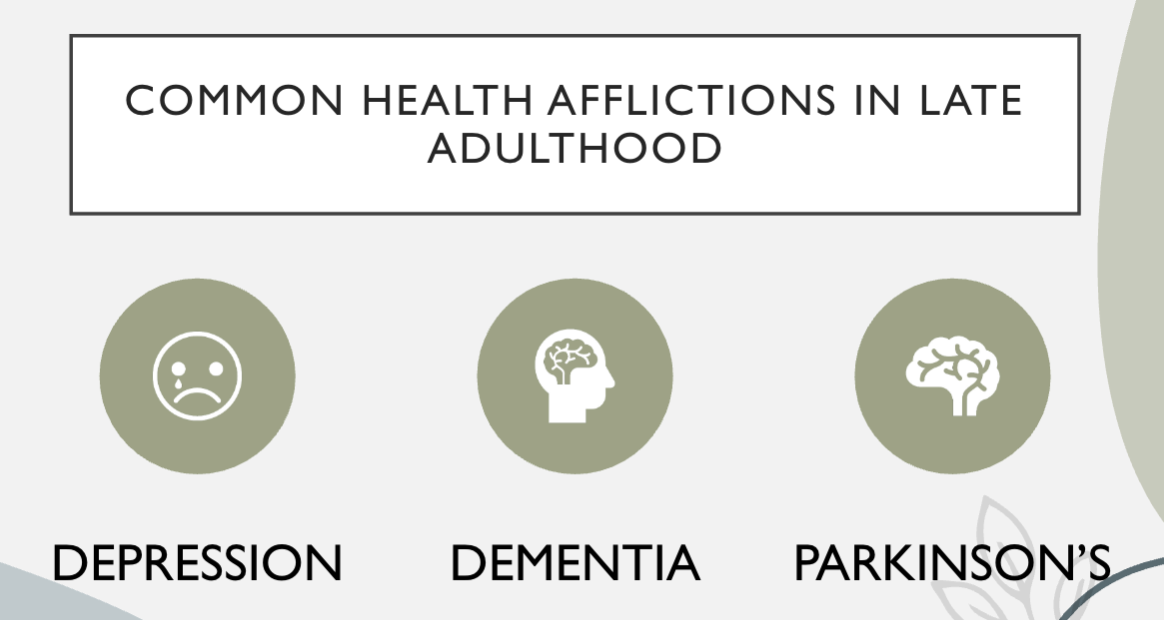Chapter 18
Cognitive Development in Late Adulthood

Cognitive Processes
The decline of fluid intelligence is more noticeable in late adulthood
Accumulated knowledge may compensate to some degree for slower processing speed in older adults
This decline is likely due to a decline in overall functioning of the brain and central nervous system

Attention
Changes in attention are very important aspects of cognitive again.
Older adults’ ability to ignore distracting information decreases
Performance on divided attention and sustained attention tasks only seem to worsen if the task is complex
Wisdom and experience may offset some of the decline
Example: older adults are less likely to get distracted by their phone while driving, than teenagers and young adults
Memory
researchers have found that…
Aging is linked to a decline in explicit memory (the conscious remembering of facts and experiences)
Implicit memory (memory without conscious recollection) is less likely to be affected by aging.
Example: older adults are more likely to forget what items they wanted to buy at a grocery store than they are to forget how to drive a car.
Perceptual speed may be slower (in driving), but they will remember how to do it.
Episodic and Semantic
Episodic memory is the retention of information about the details of our own life.
The color of the walls in your childhood bedroom, what your first date was like, what you ate for breakfast today.
Semantic memory is a person’s knowledge about the world (facts and general information).
General academic knowledge, the names of famous people, significance of important dates/places, the meaning of words
Most of this knowledge will lack recollection of when/where/how the information was learned
Episodic and Semantic Decline
Older adults often take longer to retrieve semantic information, but they can ultimately retrieve it.
However, the ability to retrieve very specific information (such as names) usually declines in late adulthood.
For the most part, episodic memory declines more than semantic memory.
A common memory problem for older adults is the tip-of-the-tongue (TOT) phenomenon - a cognitive error that occurs when a person is confident that they know a word but can’t say it.
They may have partial information about the word: its meaning, grammatical features 9first letter), or sound patterns (“sounds like __”).
Examples of Tip-of-the-tongue tasks
Picture naming: Showing someone a picture of an uncommon object and asking them to name it
Defenition-based recall: giving a definition of a word and asking participants to provide the word itself.
Celebrity naming: presenting a picture of a famous person and asking for their name
Foreign language translation: asking someone to translate a common word from their dominant language to their less dominant language.
If participants cannot recall the word but feel like they are close to remembering it, they are experiencing the TOT phenomenon.
Source and Prospective
Source memory is the ability to remember where one learned something.
Failures of source memory increase with age
Prospective memory involves remembering to do something in the future.
E.g., remembering to take your medication or remembering to run an errand
Prospective memory plays a very important role in independent maintenance in late adulthood.
The decline of prospective memory depends on context.
Age-related deficits occur more often in tasks that are time-based than those that are event-based.
Remembering to call someone on Friday vs. remembering to ask your friend about the cost of their vacation once they return
use it or lose it
Mental activities can benefit the maintenance of cognitive skills
Reading books
Doing crossword puzzles
Going to lectures
Going to concerts
Research suggests that enagging in mental exercisies regularly in late adulthood may…
Reduce cognitive decline
Lower the liklihood of developing specific types of dementia
Increase overall life satisfaction and seld-esteem
Work and Retirement
Cognitive ability is one of the best predictors of job performance in older adults.
Older workers, in comparison to their younger counterparts:
Have lower rates of absenteeism
Higher job satisfaction
Increasing number of adults are beginning to reject the early retirement option.
On average, those who retire spend 10 years in retirement (compared to the previous generation ~ 25 years in retirement)
Retirement trends
researchers noted that when people reach their 60s, the life path they follow has become less clear as a population:
Some don’t retire, continuing in their career jobs.
Some retire from their career work and then take up a new and different jjob.
Some retire from career jobs but continue volunteer work.
Some move in and out of the workforce (retire, then come out of retirement).
Some never really have a ‘caeer” job from which they can retire
Some who are in poor health move to a disability status and eventually into retirement.
Some are forced into retirement involuntary due to physical or cognitive decline.
Some who are laid off define it as “retirement.”

Depression
Major Depressive Disorder (MDD) is an affective, or mood, disturbance that can be accompanied by cognitive difficulties.
NOT associated with age or cognitive decline.
Mose common and treatable (mood) disorder among older adults.
Common predictors
Earlier depressive symptoms
Poor health or disability
Loss events
Low social support.
Characteristics of Depression in older Adults
Dysphoria (general feeling of sadness)
Feelings of helplessness
Social with drawl
Insomnia or hypersomnia
Lack of self-care
Changes in appetite
symptoms must last for more than 2 weeks to rule out “momentary mood changes”
Substance abuse or medical reasons must be ruled out
Dementia
Dementia is a neurotypical disorder in which primarily symptoms involve deterioration of mental functioning.
Less than 1% of young-old (65-74) are affected
At least 50% of oldest-old are affected
There are more than 12 forms of dementia that have been identified as of 2017
Most common:
Alzheimer’s Disease
Vascular Dementia
Dementia due to Parkinson’s Disease
Alzheimer’s Disease (AD)
Alzheimer’s Disease is an irreversible brain disorder characterized by the gradual deterioration of memory, reasoning, language, and (eventually) physical function.
Cannot be stopped or cured
About 50% of older adults with Dementia have AD
Women ar more likely to develop AD because they live longer than men.
AD can be diagnosed with mental status exams
Progression of AD
AD comes on gradually and with a steady downhill progression
Early-stage patients can exhibit:
Moderate memory loss
Difficulty planning or solving problems
Inability to tell time.
Misplacing items very often
Confusion with location or navigation
In later stages, cognitive functions will be severely impaired, and patients may develop aphasia - loss of language (production or understanding).
Parkinson’s DIsease (PD)
Parkinson’s disease is a chronic, progressive disease characterized by muscle tremors, slowing of movement, and partial facial paralysis
Around 1.3% of young-old (65-74) are affected
Almost 9% of oldest-old (85+) are affected
There is no cure for PD, but some treatments exist to help manage symptoms.
PD affects more males than females.
Some people with Parkinson’s will develop demential and severe cognitive impairment
 Knowt
Knowt